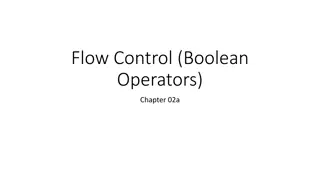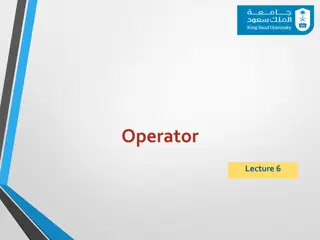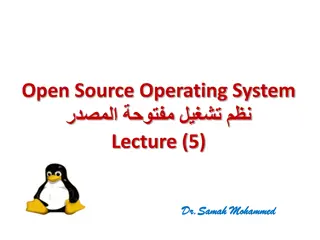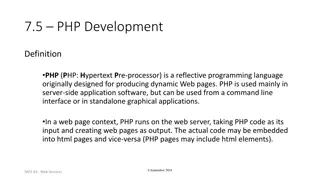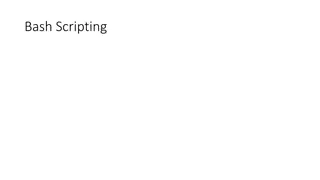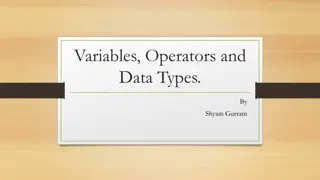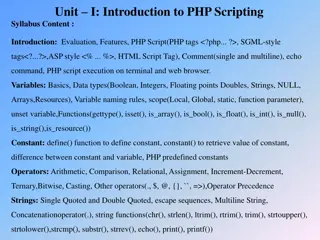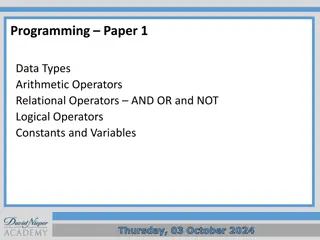Introduction to PHP Scripting Language and Operators
This content provides an overview of PHP, a server-side scripting language used to create dynamic and interactive web pages. It covers the basics of PHP scripting blocks, variable usage, operators, and their examples. Additionally, it explains common PHP operations like addition, subtraction, multiplication, division, and comparison operators.
Download Presentation

Please find below an Image/Link to download the presentation.
The content on the website is provided AS IS for your information and personal use only. It may not be sold, licensed, or shared on other websites without obtaining consent from the author.If you encounter any issues during the download, it is possible that the publisher has removed the file from their server.
You are allowed to download the files provided on this website for personal or commercial use, subject to the condition that they are used lawfully. All files are the property of their respective owners.
The content on the website is provided AS IS for your information and personal use only. It may not be sold, licensed, or shared on other websites without obtaining consent from the author.
E N D
Presentation Transcript
PROF. S. LAKSHMANAN, DEPT. OF B. VOC. (SD & SA), ST. JOSEPH'S COLLEGE.
PHP stands for PHP: Hypertext Preprocessor PHP is a server-side scripting language, like ASP PHP scripts are executed on the server PHP supports many databases PHP is an open source software PHP is free to download and use Tool for making dynamic and interactive web page
A PHP scripting block always starts with <?php and ends with ?>. A PHP scripting block can be placed anywhere in the document. Each code line in PHP must end with a semicolon. The semicolon is a separator and is used to distinguish one set of instructions from another. There are 2 basic statements to output text with PHP: echo and print.
<html> <body> <?php echo "Hello World"; ?> </body> </html> Note: The file must have a .php extension.
All variables in PHP start with a $ sign symbol. <?php $txt="Hello World!"; $var_name = value; ` $x=16; $txt="Hello World"; echo $txt; ?>
Operator Description Example Result + Addition x=2 x+2 x=2 5-x x=4 x*5 15/5 5/2 5%2 10%8 10%2 x=5 x++ x=5 x-- 4 - Subtraction 3 * Multiplication 20 / Division 3 2.5 1 2 0 x=6 % Modulus (division remainder) ++ Increment -- Decrement x=4
Operator Example Is The Same As = x=y x=y += x+=y x=x+y -= x-=y x=x-y *= x*=y x=x*y /= x/=y x=x/y .= x.=y x=x.y %= x%=y x=x%y
Operator Description Example == is equal to 5==8 returns false != is not equal 5!=8 returns true <> is not equal 5<>8 returns true > is greater than 5>8 returns false < is less than 5<8 returns true >= is greater than or equal to 5>=8 returns false <= is less than or equal to 5<=8 returns true
Operator Description Example x=6 y=3 && And (x < 10 && y > 1) returns true x=6 y=3 || Or (x==5 || y==5) returns false x=6 y=3 ! Not !(x==y) returns true
if (condition) code to be executed if condition is true; Example <?php $d=date("D"); if ($d=="Fri") echo "Have a nice weekend!"; ?>
Use the if....else statement to execute some code if a condition is true and another code if a condition is false. Syntax if (condition) code to be executed if condition is true; else code to be executed if condition is false;
Syntax if (condition) code to be executed if condition is true; elseif (condition) code to be executed if condition is true; else code to be executed if condition is false;
Used to select one of many blocks of code to be executed. switch (n) { case label1: case label2: default: } code to be executed if n=label1; break; code to be executed if n=label2; break; code to be executed if n is different from both label1 and label2;
The while loop executes a block of code while a condition is true. Syntax while (condition) { code to be executed; }
Example <?php $i=1; ?> while($i<=5) { } echo "The number is " . $i . "<br />"; $i++;
The do...while statement will always execute the block of code once, it will then check the condition, and repeat the loop while the condition is true. Syntax do { } while (condition); code to be executed;
Syntax for (init; condition; increment) { code to be executed; } Parameters: init: Mostly used to set a counter (but can be any code to be executed once at the beginning of the loop) condition: Evaluated for each loop iteration. If it evaluates to TRUE, the loop continues. If it evaluates to FALSE, the loop ends. increment: Mostly used to increment a counter (but can be any code to be executed at the end of the loop) Note: Each of the parameters above can be empty, or have multiple expressions (separated by commas).
The foreach loop is used to loop through arrays. Syntax foreach ($array as$value) { code to be executed; } For every loop iteration, the value of the current array element is assigned to $value (and the array pointer is moved by one) - so on the next loop iteration, you'll be looking at the next array value.
Example <?php $x=array("one","two","three"); foreach ($x as $value) { echo $value . "<br />"; } ?>
The include() statement includes and evaluates the specified file. vars.php <?php $color = 'green'; $fruit = 'apple'; ?> test.php <?php echo "A $color $fruit";// A include 'vars.php'; echo "A $color $fruit";// A green apple ?>
An array is a special variable, which can store multiple values in one single variable. In PHP, there are three kind of arrays: Numeric array An array with a numeric index Associative array An array where each ID key is associated with a value Multidimensional An array containing one or array more arrays
A numeric array stores each array element with a numeric index. There are two methods to create a numeric array. 1. In the following example the index are automatically assigned (the index starts at 0): $cars=array("Saab","Volvo","BMW","Toyota"); 2. In the following example we assign the index manually: $cars[0]="Saab"; $cars[1]="Volvo"; $cars[2]="BMW"; $cars[3]="Toyota";
An associative array, each ID key is associated with a value. When storing data about specific named values, a numerical array is not always the best way to do it. With associative arrays we can use the values as keys and assign values to them.
For (eg) we use an array to assign ages to the different persons Example 1 $ages = array("Peter"=>32, "Quagmire"=>30, "Joe"=>34); Example 2 $ages['Peter'] = "32"; $ages['Quagmire'] = "30"; $ages['Joe'] = "34";
In a multidimensional array, each element in the main array can also be an array. And each element in the sub-array can be an array, and so on. Example $families = array ( "Griffin"=>array ( "Peter ,"Lois ,"Megan ), "Quagmire"=>array ( "Glenn ), "Brown"=>array ("Cleveland ,"Loretta ,"Junior ) );
A function will be executed by a call to the function. Syntax function functionName() { code to be executed; } Note : The function name can start with a letter or underscore (not a number)
<?php function writeName() { echo Srivanth"; } echo "My name is "; writeName(); ?>
<?php function writeName($fname) { echo $fname . <br />"; } echo "My name is "; writeName( Jim"); echo "My sister's name is "; writeName( TTT"); echo "My brother's name is "; writeName( Sri"); ?>
<?php function add($x,$y) { $total=$x+$y; return $total; } echo "1 + 16 = " . add(1,16); ?>
Any form element in an HTML page will automatically be available to your PHP scripts. Eg) <html> <body> <form action="welcome.php" method="post"> Name: <input type="text" name="fname" /> Age: <input type="text" name="age" /> <input type="submit" /> </form> </body> </html>
Welcome.php <html> <body> Welcome <?php echo $_POST["fname"]; ?>!<br /> You are <?php echo $_POST["age"]; ?> years old. </body> </html>
The predefined $_POST variable is used to collect values from a form sent with method="post". Information sent from a form with the POST method is invisible to others and has no limits on the amount of information to send.
The predefined $_GET variable is used to collect values in a form with method="get Information sent from a form with the GET method is visible to everyone (it will be displayed in the browser's address bar) and has limits on the amount of information to send.
Eg1.html <form action="welcome.php" method="get"> Name: <input type="text" name="fname" /> Age: <input type="text" name="age" /> <input type="submit" /> </form> Welcome.php Welcome <?php echo $_GET["fname"]; ?>.<br /> You are <?php echo $_GET["age"]; ?> years old!
The predefined $_REQUEST variable contains the contents of both $_GET, $_POST, and $_COOKIE. The $_REQUEST variable can be used to collect form data sent with both the GET and POST methods. Example Welcome <?php echo $_REQUEST["fname"]; ?>!<br /> You are <?php echo $_REQUEST["age"]; ?> years old.
A cookie is often used to identify a user. A cookie is a small file that the server embeds on the user's computer. Each time the same computer requests a page with a browser, it will send the cookie too. In PHP, you can both create and retrieve cookie values.
The setcookie() function is used to set a cookie. The setcookie() function must appear BEFORE the <html> tag. setcookie(name, value, expire, path, domain); Example <?php setcookie("user", SRI", time()+3600); ?> <html> ..... In our eg) Cookie name is SRI. It expires after one hour.
The PHP $_COOKIE variable is used to retrieve a cookie value. Example <?php echo $_COOKIE["user"]; // Print a cookie ?> It is a way to view the cookie named user and display it on a page
<html> <body> <?php if (isset($_COOKIE["user"])) echo "Welcome " . $_COOKIE["user"] . "!<br />"; else echo "Welcome guest!<br />"; ?> </body> </html> isset() Find out if a cookie has been set
When deleting a cookie you should assure that the expiration date is in the past. Example <?php // set the expiration date to one hour ago setcookie("user", SRI", time()-3600); ?>
It allows you to store user information on the server for later use (i.e. username, shopping items, etc). However, session information is temporary and will be deleted after the user has left the website. If you need a permanent storage you may want to store the data in a database. Sessions work by creating a unique id (UID) for each visitor and store variables based on this UID.
Starting a PHP Session PHP session, you must first start up the session. Before you can store user information in your <?php session_start(); ?> <html> <body> </body> </html> Note: The session_start() function must appear BEFORE the <html> tag.
Storing a Session Variable variables is to use $_SESSION variable. <?php session_start(); $_SESSION['views']=1; // store session data ?> The correct way to store and retrieve session To Retrieve session data <?php echo "Pageviews=". $_SESSION['views']; ?>




